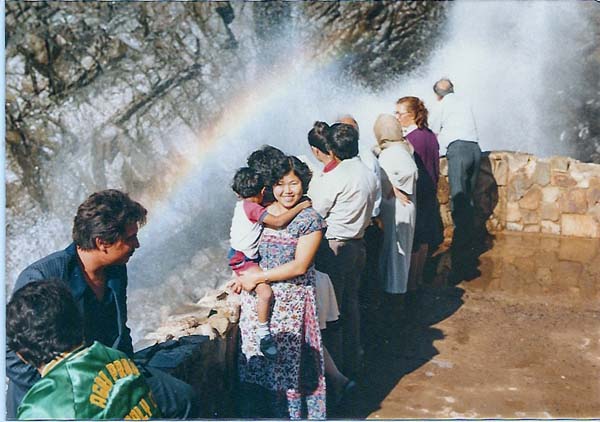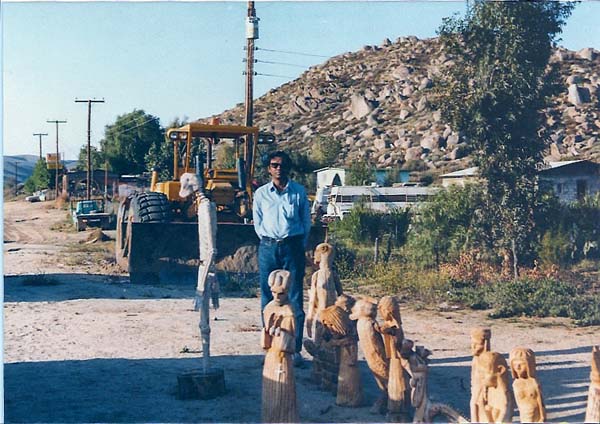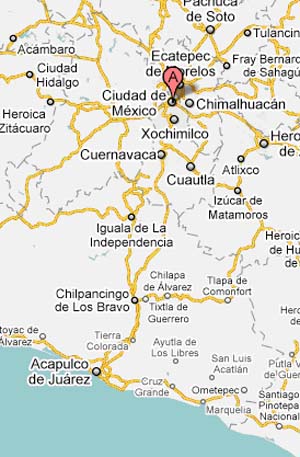The Travels of a Journalistâ€â€ÂÂ27 (Part B)-A PEEK INTO MEXICO: THROUGH A CAPITAL TRAP IN 1967
Posted on May 16th, 2010
By Shelton A. Gunaratne ƒÆ’-¡ƒ”š‚© 2010
ƒÆ’-¡ƒ”š‚ Nostalgia overwhelmed me when I listened to Neil DiamondƒÆ’‚¢ƒ¢-¡‚¬ƒ¢-¾‚¢s famous lyric years after I first visited Ensenada in 1983:
In Ensenada
We were running
from the things that we knew best
We only took the good and left the rest
In Ensenada
Small mountain ranges back the Ensenada landscape giving it much of its charm.
Ensenada lies in the heart of a wine country that many compare with the Napa Valley of California. The story goes that the first vitis vinifera (Common Grape Vine) made it to the peninsula (specifically to the San Ignacio Mission) in 1703, when Jesuit Padre Juan de Ugarte planted the first vineyards there. I bet the wine we drank with our superlative dinner Friday came from a local winery.
Located in the BahƒÆ’†’ƒ”š‚a de Todos Santos, Ensenada is formally known as Ensenada de Todos Santos. It is also the municipal seat of Ensenada Municipality and the third largest city in Baja California. It is an important commercial and fishing port as well as a cruise ship stop. Navy and Army bases and a military airfield have added to the cityƒÆ’‚¢ƒ¢-¡‚¬ƒ¢-¾‚¢s economic power.
Ensenada Experience
ƒÆ’-¡ƒ”š‚ Saturday (12 Nov.) morning, we ate breakfast at the Best Western coffeehouse on Avenida Lopez Mateos. Then, despite a light rain, we ambled to the Tourist Information Office to plan our day. At the FONART, just across Arroyo de Ensenada, we bought an ashtray and a wall tray for 160 pesos ($10.70) because we wanted to splurge the Mexican currency we exchanged on arrival.
At 11 a.m., we joined a tour of the Bodegas [Winery] de Santo Tomas ($1.50 per person). Located 44 km south of Ensenada, this winery has been in operation since 1888. It is known for its Duetto, a 50-50 Santo Tomas/Wente blend, and for its Santo TomƒÆ’†’ƒ”š‚¡s Reserva Unico. ƒÆ’-¡ƒ”š‚ However, despite the availability of good wines, the average wine consumption per capita in Mexico is only two glasses a year. The Mexican government imposes a tax of 40 percent per bottle, making it hard to compete with beer and tequila.
After the tour, we drove to the hilly northern end of Avenida Moctezuma to get a good view of the bay and its surroundings. Then, we proceeded to the top of Chapultepec Hills to see the fashionable residential neighborhood.
We returned to the city center and stopped at Plaza Civica on Boulevard Costero to look at the 12-ft.-high busts of three historical figures: Benito Juarez, Miguel Hidalgo and Venustiano Carranza. Then, we went to see the former Hotel Riviera del Pacific, a bay front casino and resort of the 1930s, now renovated as the cityƒÆ’‚¢ƒ¢-¡‚¬ƒ¢-¾‚¢s cultural, arts and convention center.
In the afternoon, we ate at a bakery on Avenida Ruiz before going on another shopping spree. At Beauty Supply, I bought two leather belts ($4.50 each) and a pair of Hines bookends ($18). At La Perla del Pacifico, I bought a pair of G.B.H. leather shoes ($38) and two pairs of socks ($2.54). At Fashions, Yoke-Sim bought a leather bag ($25) and a blanket ($13). Poor Junius bought nothing.
We ate a good seafood dinner for $21 at the seafront Restaurant Casamar (987 Blvd Costero). The dayƒÆ’‚¢ƒ¢-¡‚¬ƒ¢-¾‚¢s drizzle continued even at bedtime.
Sunday (13 Nov.) was our last day in Mexico.ƒÆ’-¡ƒ”š‚ In the morning, we drove southwest to reach the western tip of Punta Banda to see La Bufadora, a marine geyser or Blowhole (see photo). The ocean waves and air drawn into an underwater cave point on the Cliffside creates the spout of marine water that occurs every minute or so to varying degrees of height. The trapped air and water then explode upwards.
On the return journey, we stopped at the resort on Estero Beach and walked on the large expanse of sand.ƒÆ’-¡ƒ”š‚ Back in Ensenada, we checked out of our motel at noon and stepped into Casamar No. 2 (at the bay end of Avenida Macheros) to eat shrimp and crab salad for lunch. At RobertƒÆ’‚¢ƒ¢-¡‚¬ƒ¢-¾‚¢s Gifts (on Avenida Lopez Mateos), I purchased a PaditoƒÆ’‚¢ƒ¢-¡‚¬ƒ¢-¾‚¢s goatskin jacket ($68) while Yoke-Sim bought a sheet ($14).
Having disposed of our greenbacks in almost one fell sweep, we said despedida to Ensenada at 2 p.m. We traveled more than 100 km (66 miles) north on Mexico 3 to the border city of Tecate. On the way, we passed El Sauzal; Guadalupe, where I climbed up to see the site of Mission Nuestra Senora de Guadalupe (1834); El Testerazo, where we saw cottonwood carvings (see photo); and Valle de Las Palmas.
Tecate is a small city best known outside of its region as the home of Tecate beer and author Daniel Reveles, a fictional writer. Tecate border crossing is much less crowded than San Ysidro (Tijuana) or Mexicali. We tarried at Parque Hidalgo and at FONART, and bought some pastry at a Tecate bakery before we crossed the border to the United States at 5 p.m.
We ate Kentucky Fried Chicken for dinner at San Clemente, the home base of disgraced U.S. President Richard Nixon. We were back in Fullerton at 9 p.m. But we couldnƒÆ’‚¢ƒ¢-¡‚¬ƒ¢-¾‚¢t immediately get into LarryƒÆ’‚¢ƒ¢-¡‚¬ƒ¢-¾‚¢s condo because our remote control gadget in the car failed to open theƒÆ’-¡ƒ”š‚ garage door.
Recalling Mexico 1967
The U.S. State DepartmentƒÆ’‚¢ƒ¢-¡‚¬ƒ¢-¾‚¢s intermittent warnings about the dangers of touring Tijuana and many other Mexican cities are not based on hearsay alone. I became the victim of a tourist swindle on my first visit to Mexico City in 1967 as the Ceylon member of that yearƒÆ’‚¢ƒ¢-¡‚¬ƒ¢-¾‚¢s World Press Institute group of journalists. (All of the 1966-67 WPI journalists, except the late Kebede Anissa from Ethiopia, visited Mexico on the invitation of Consejo Nacional de Turismo even though we clearly understood this to be a public relations exercise of the Mexican government.
We arrived in Mexico City on a Wednesday (12 July) evening by Aeronaves de Mexico from New York. CNT officials welcomed us and took us to Hotel Del Prado on Avenida Juarez. Ben Antao (India) and I set off to explore the streets when a fellow approached us and volunteered to take us to a private club.ƒÆ’-¡ƒ”š‚
Thursday (13 July) morning, CNT folks showed us the Olympic installations. Robert Kenny, the director of special events, told us about the arrangements made to cover events. The Committee of the Olympic games gave us a luncheon at the Bay Horse Inn on Avenida Conscripto with folk singers and banjo players in the background. In the evening, I explored the streets to the west of our hotel.
We visited the National Museum of Anthropology and History Friday (14 July) morning. Then, we paid a courtesy call on Mexico President Miguel Aleman Valdez (1946-1952), who headed the CNT during our visit. We toured the Chapultepec Park before attending a luncheon at the Presidente Hotel. In the evening, the International Press Club invited us for cocktails at the Continental Hilton, where I chatted with Turkish journalist Rosita ƒÆ’‚¢ƒ¢-¡‚¬ƒ…-DebraƒÆ’‚¢ƒ¢-¡‚¬ƒ”š‚ Saalie.
On Saturday (15 July), we went on a tour of the Three Cultures Square and the archeological zone of TeotihuacƒÆ’†’ƒ”š‚¡n, about 32 miles northeast of Distrito Federal.
- The square contains the remains of Aztec temples and is flanked by the Catholic church of Santiago Tlatelolco and a massive housing complex built in 1964. The former headquarters of the Secretariat of Foreign Affairs are now a memorial museum to remember the 1968 Mexican student demonstrations and the Tlatelolco Massacre victims and survivors. The name “Three Cultures” is in recognition of the three periods of Mexican history reflected by those buildings: pre-Columbian, Spanish colonial, and the independent ƒÆ’‚¢ƒ¢-¡‚¬ƒ…-MesitzoƒÆ’‚¢ƒ¢-¡‚¬ƒ”š‚ nation. (Wikipedia)
- Teotihuacan is an enormous archaeological site in the Basin of Mexico, containing some of the largest pyramidal structures built in the pre-Columbian Americas [c. 200 BCE]. Apart from the pyramidal structures, Teotihuacan is also known for its large residential complexes, the Avenue of the Dead, and numerous colorful, well-preserved murals. (Wikipedia)
On Sunday (16 July) about 11 a.m., I was walking on Paseo de La Reforma, when an elderly man claiming to be a rich rancher from Sonora stopped me and wanted to know how he could change the $100 bills he had in his pocket. Just at the moment, the old man accosted another passer-by with whom he spoke in Spanish ostensibly making the same inquiry. The newcomer translated to me in English what the old man told him in Spanish. This developed into a friendly conversation; and the pair invited me to join them for a tour of the vicinity. In my mind, the old man appeared to be lost in the big city and in need of some help. Despite my extensive travels in the big cities in the United States, not the faintest suspicion arose in my mind when I said OK.
We got into the passerƒÆ’‚¢ƒ¢-¡‚¬ƒ¢-¾‚¢s-by car, which he stopped at a waterhole with a billiard room. The ƒÆ’‚¢ƒ¢-¡‚¬ƒ…-rancherƒÆ’‚¢ƒ¢-¡‚¬ƒ”š‚ and the ƒÆ’‚¢ƒ¢-¡‚¬ƒ…-good SamaritanƒÆ’‚¢ƒ¢-¡‚¬ƒ”š‚ got cozy at playing billiards with the ƒÆ’‚¢ƒ¢-¡‚¬ƒ…-rancherƒÆ’‚¢ƒ¢-¡‚¬ƒ”š‚ betting his $100 bills. TheƒÆ’-¡ƒ”š‚ ƒÆ’‚¢ƒ¢-¡‚¬ƒ…-rancherƒÆ’‚¢ƒ¢-¡‚¬ƒ”š‚ bungled the games badly and lost a couple of times. The winner egged me on to play with the ƒÆ’‚¢ƒ¢-¡‚¬ƒ…-rancher,ƒÆ’‚¢ƒ¢-¡‚¬ƒ”š‚ who again bungled the game against a billiards novice of my dubious caliber. Suspicion began to stir in my mind when the pair asked me to bet my camera and wristwatch, in addition to my original bet for 100 pesos.ƒÆ’-¡ƒ”š‚ The bungling rancher instantly turned into a master player of billiards claiming possession of all the material wealth I carried.
My gut instincts turned on at top gear as I told the bunch of swindlers that I was in Mexico as the guest of President Aleman and the CNT, who must be already looking for me. Then, I grabbed hold of my camera and the wristwatch and dashed out of the billiards room out into the streets against all the threats. I lost only the 100 pesos.ƒÆ’-¡ƒ”š‚ Nobody shot at me or followed me. Nevertheless, it was an incredible risk.
That evening, I joined the WPI group to see the Ballet Folklorico de Mexico at Palacio de Bellas Artes.
On Tuesday (18 July) morning, we left Mexico City for Taxco (pop. 50,000), where we stayed overnight at Posada de La Mision. On the way, 53 miles (85 km) south of D.F., we stopped at Cuernavaca (pop. 350,000), the capital and the largest city of the state of Morelos, where we spent some time at CortesƒÆ’‚¢ƒ¢-¡‚¬ƒ¢-¾‚¢ Palace and the Central Square.
Taxco, located in the north-central part of the state of Guerrero (about 170 km/105 miles southwest of D.F.), is a colonial monument town with twisting cobble-stoned streets and steep hills dotted with tile-roofed houses displaying 16th century architecture. Taxco is famous for silver. We spent the entire evening walking on winding streets and the market center facing the church of Santa Pisca. Taxco is unique, just beautiful and peaceful.
Wednesday through Friday (19-21 July), we had an uninterrupted vacation at the Las Brisas resort in Acapulco (pop. 617,000), a coastal city in the state of Guerrero 300 km/186 miles southwest of D.F. My diary entry for Friday reads: I spent the morning swimming in the pool. I didnƒÆ’‚¢ƒ¢-¡‚¬ƒ¢-¾‚¢t join the group who went yachting. I had a hearty meal in the open-air dining area near the pool and the cabanas. In the evening, we went to see the divers in action at La Quebrada. Diving into the sea from the steep hill seemed to be a marvelous feat. A few of us spent the rest of the night at Dali Bar at the hotel.
Saturday (22 July) morning, Arturo von Vacano Alberta, the WPI journalist from Bolivia, helped me write in Spanish my letter of resignation from Lake House. At noon, we left Acapulco to return to Mexico City, D.F. We stopped for food at Chilpancingo (pop. 167,000), the capital of Guerrero located 130 km/83 miles north of Acapulco. Back in D.F., we checked in again at Hotel Del Prado. Two Mexican socialites, Anna Luisa and Mercedes, joined me for dinner.
Sunday (23 July) at 9.30 a.m., we left our hotel for the return flight to New York. A few journalists decided to fly directly to their home counties. Only Ko Shioya (Japan), Veikko Pajunen (Finland), Hector Olave Vallejos (Chile), Pietro Banas (Italy), Ted Miller (our WPI minder), Ben, Arturo and I were on Flight AF-700.
A story about us (the WPI group) appeared in The News, a Mexico publication in English. It included a photo of mine.ƒÆ’-¡ƒ”š‚
ƒÆ’-¡ƒ”š‚
Next: Making the Best of Metropolitan Los Angeles
(The writer is a professor of mass communications emeritus, Minnesota State University Moorhead.)
ƒÆ’-¡ƒ”š‚
Figure 1: The 1967 WPI Tour Route of Mexico. From A=Ciudad de Mexico (Mexico City) to Acapulco through Cuernavaca, Taxco, and ChilpancingoƒÆ’-¡ƒ”š‚ 
Picture 1: We drove southwest of Ensenada to reach the western tip of Punta Banda to see La Bufadora, a marine geyser or Blowhole. The camera distracted Yoke-Sim while Junius got an eyeful of La Bufadora (13 Nov. 1983).

ƒÆ’-¡ƒ”š‚ Picture 2: We stopped at El Testerazo, where we saw cottonwood carvings. The author hobnobs with several carved characters. (13 Nov. 1983)
